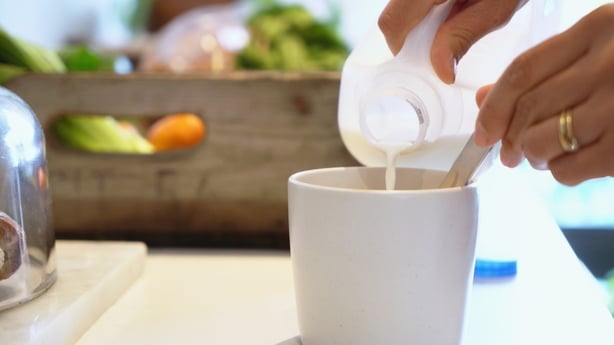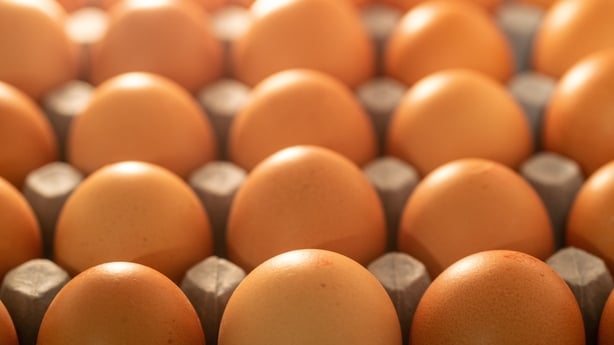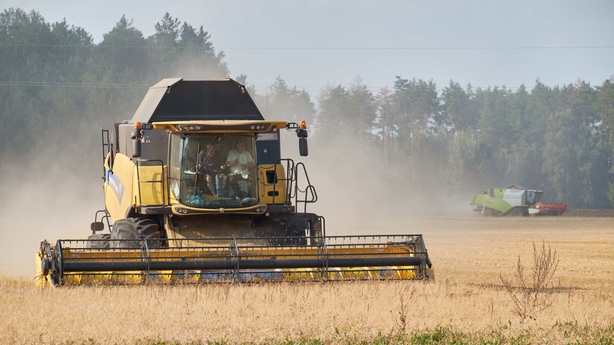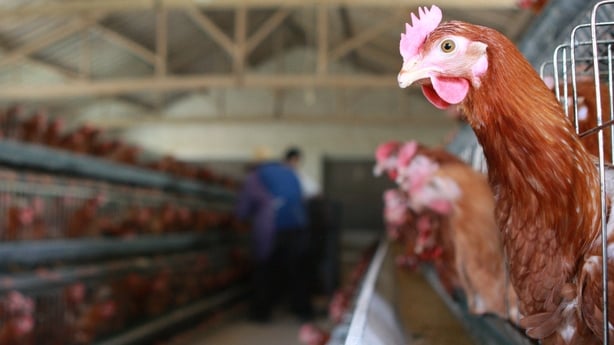Last week the Central Statistics Office confirmed that Irish consumer prices were 6.3% higher in August than in the same month of last year.
But with prices now rising for more than two years, that figure only tells half the story.
When comparing prices last month to those facing consumers in August 2021, it shows inflation of 15.6% in a mere 24 months.
And, for some everyday items, the increases are even more dramatic than that.
Take, for example, dairy and eggs.
What's happened with dairy prices?
We need your consent to load this rte-player contentWe use rte-player to manage extra content that can set cookies on your device and collect data about your activity. Please review their details and accept them to load the content.Manage Preferences
In that same two year span, CSO data shows significant price increases across a range of dairy prices.
Fresh whole milk is the worst affected – with prices up more than 29% in the past two years.
Butter prices are 25% higher in the same timeframe, while yoghurt prices are up more than 23%.
Low fat milk, meanwhile, has risen by 21% while cheese and curd is just behind at 20%.
All of those represent significant price rises in two years – and all well above the overall inflation average.
But didn’t retailers cut dairy prices recently?

They did - and to some extent that’s reflected when you look at the data on a monthly basis.
In August whole milk was about 0.5% cheaper than it was in July. Yoghurt was 0.8% cheaper.
But there is a caveat to add to those retailers’ price cuts – because they were all centred around own brand prices. They were not an across-the-board reduction in price.
You would assume the branded alternatives would feel the pressure to follow suit in order to remain competitive, but some may have decided not to. Or, perhaps, they have taken a bit longer to bring their prices down.
But even accounting for that, what’s clear from the data is that those high profile price cuts to not undo the increases consumers have suffered in the past two years.
They may be welcome, but we’re still paying more for basic goods than was the case in 2021.
What about eggs?

Prices there are up more than 26%in the past two years, according to the CSO. So another significant increase.
And, much like sugar and flour, dairy and eggs are likely to be standard shopping basket items. These are the kind of price rises that will impact most household budgets.
Also like flour and sugar, dairy and eggs are also going to be the types of products that are an ingredient in many of the other foods we buy.
Baked goods, especially pastries, can have plenty of dairy in there. So can chocolate, pre-made coffee drinks, smoothies or soups.
Eggs can also turn up in plenty of baked goods like cakes as well as some breads, pancakes, waffles and, of course, plenty of sauces like mayonnaise.
So their higher prices will have a knock-on effect on so many other household staples.
What’s the reason behind these price jumps?
When we’re talking about rising prices, you very quickly come back to rising energy costs.
And naturally that brings us to Russia’s invasion of Ukraine.
But maybe more than anything else, dairy and eggs are some of the products most affected by the war in Ukraine.
Even though it’s all made here?

Yes – and it’s often a point of pride that Ireland produces so much more food than we need. We have great "food security", on paper at least.
But it’s not really that simple.
Because, while it is true that we produce more than enough dairy, eggs, beef to satisfy Irish consumers’ demands – our agriculture industry is still very much exposed to the whims of the global market.
Energy is a good example of that.
Dairy is a very energy intensive process, from milking to processing and pastuerisation, to storage at low temperatures, and then transportation.
And, as we know, we’re far from self-sufficient in terms of our energy supply. So when you have a major global shock – like Russia invading Ukraine – the impact that has on energy prices has a knock-on effect on our food supply.
Farmers and dairy processers have been hit by significant energy price increases in the past two years.
If you look at the most recent agricultural price index from the CSO, which brings us to July, it would tell you energy prices are 13% lower year-on-year.
But that’s on the back of a huge spike last year.
When you do a two year comparison on those costs, you can see that agricultural energy prices are still more than 31% higher than they were two years ago.
But that’s not the only thing that’s gotten more expensive for them…
No – because we’re also not self-sufficient in terms of animal feed.
In fact last year there was an increase in the amount of feed like barley, wheat and maize, that was imported into the country.
Ukraine and Russia were an important source of grain pre-war, so supply from that region has been significant impacted in the past two years.
That means the cost of feeding the animals that produce our milk or eggs is now higher than it was before.
Like with energy, it’s fallen in the past year. The CSO says agricultural feeding stuffs prices is down 3% in the year to July.
But on a two year basis, the prices are more than 31% higher.
Of course we can grow plenty of grass here – which helps feed many of our farm animals.
But the industry’s reliance on other countries is just shifted when it comes to grass-fed, because farmers need fertiliser to help make the grass grow.
Once again, Ukraine and Russia were important sources of fertiliser in the past – and so the price has jumped since the start of the war.
According to the CSO, fertiliser prices fell by 44% in the year to July.
But they’re still more than 30% higher compared to July 2021 – highlighting just how much the cost jumped by following Russia’s invasion of Ukraine.
And, aside from that, there’s another odd way that the war in Ukraine has affected our dairy prices.
What’s that?

The disruption to grain exports from Ukraine and Russia to other countries has had a significant destabilising effect on food supplies around the world, particularly to poorer countries.
That’s led to an increase in demand for alternatives.
That demand is coming from countries that need food right now, but also countries that are looking at the disruption to global supply and deciding to stockpile to insulate themselves from future shocks.
As a result dairy and egg exports jumped in the past two years.
The value of Irish exports in that category has risen 14% since June 2021.
That is value rather than volume - so some of that increase reflects the fact that the price of each item was higher. But you can clearly see in many cases that it’s not purely down to prices.
For example, the value of dairy and egg exports to Saudi Arabia is 133% higher in the past two years.
Exports to the 'other countries’ category, which would include a lot of smaller Asian and African countries, is up 90%.
Interestingly, the value of dairy and egg sales to a lot of other European countries is also well up in two years.
To France it’s up 137%, to Italy it’s up 186%, Belgium is up almost 69%.
That points to another factor in this, which is that farmers in other countries – that might not have the same favourable climate as Ireland – are having to spend more to produce.
Given the higher costs they’re now facing, many are scaling back production or stopping altogether.
Meanwhile countries like the Netherlands and Belgium are planning to significant cut their dairy herd over the course of this decade in order to cut their nitrogen emissions.
That means they are becoming more reliant on producers – like Ireland – for the goods they might have made for themselves before.
And there’s more competition for Irish milk and eggs, it means the price is going to go up as a result.
What impact has bird flu had?

This has obviously impacted egg production here.
It should be said that Ireland has done relatively well in terms of managing the impact of bird flu – certainly compared to the UK where last year there were around four million birds which died or were culled as a result of the disease.
That’s led to a shortage in the UK – which, again, has added to demand for Irish supply.
But controlling bird flu here has also meant that Irish farmers have been forced to keep chickens indoors at different times.
At certain stages, if you were buying ‘free range’ eggs, you would have seen a sticker on the box saying the chickens that laid them were actually housed indoors due to a government directive.
And having to accommodate that adds a cost burden on farmers too.
Add that on to all of the other costs that they’re facing around energy and feed and so on, it means that your egg has to get more expensive in order to compensate that.







